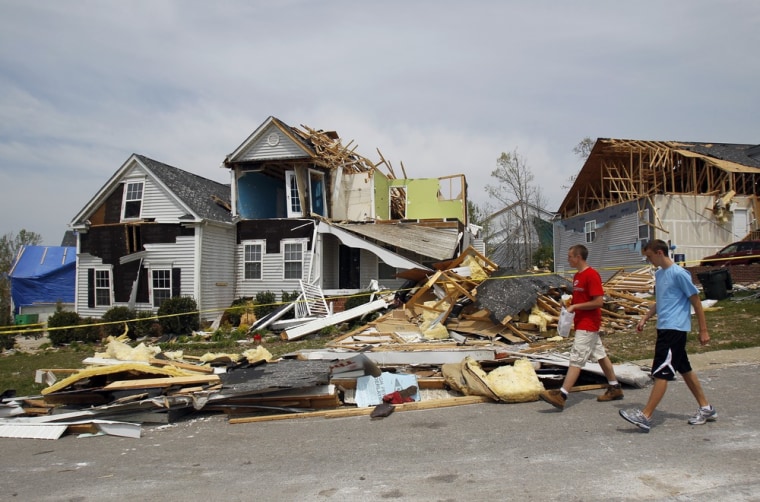Severe thunderstorms and tornadoes could hit much of the South Wednesday, a forecaster warned, a day after President Barack Obama declared a major disaster for 18 counties in storm-ravaged North Carolina.
The state's governor, Beverly Perdue, asked the federal government for help, seeking low-interest loans for farmers and loans and grants to help others repair their homes and businesses.
The state estimated the recent tornadoes damaged or destroyed more than 800 homes. Perdue also said her office has set up a disaster relief fund that will accept donations.
The tornado that carved through North Carolina's capital killed four children, shuttered a university for the rest of the spring semester and felled the signature trees in the metropolis known as the "City of Oaks."
It was the most active system of tornadoes on record in the state's history, leading to 23 deaths. In Raleigh, one of the nation's fastest-growing cities, the death toll and property damages underscored the massive costs that can be inflicted when a tornado makes a rare venture into areas of dense population.
In all, the storm killed 45 people in six states.
And were possible Wednesday in eastern Tennessee, western and central areas of North and South Carolina, northern and central parts of Georgia, Alabama and Mississippi, northern Louisiana, southern Arkansas and eastern Texas.
"Damaging winds, hail and isolated tornadoes are possible with the strongest cells," he wrote. "Thunderstorms continue in northern Alabama, northern Mississippi, western Tennessee, Arkansas and eastern Oklahoma tonight. A few of the stronger storms could produce gusty winds and some hail."
"A stray shower or thunderstorm is possible along the Gulf coast from New Orleans to Fort Myers during the afternoon and evening," he added.
Roth also warned that isolated severe thunderstorms were possible in southern New York, Pennsylvania, New Jersey, Maryland, West Virginia and Virginia. Between 6 to 12 inches of snow could fall in northern Maine, he added.
Crews struggle
North Carolina was by far the hardest-hit of the states hits by Saturday's storms.
More than three days after the storm, crews struggled Tuesday to restore electricity and infrastructure there, with a key commuting interstate briefly shut down to fix downed power lines.
Outside her apartment in downtown Raleigh, 71-year-old Elsie McKeithan wondered whether residents understood that a tornado could strike an urban area, especially with such ferocity. The storm tore the roof from the three-story apartment where she lived, rain pouring in.
"I don't think anybody grasped the concept it was going to come through downtown Raleigh," she said.
Five blocks away, Shaw University officials canceled the remainder of the semester because the storm ripped off roofs and shattered windows at campus buildings. Students were to receive grades for the work they had completed.
Up the road, even the headquarters of Progress Energy — the utility that provides electricity across much of the region — lost power and had to rely on a backup generator. The electricity was restored a day later.
The tornado inflicted its worst damage just beyond the city center, in a mobile home park with winds over 110 mph. Rosa Gutierrez said the tornado spun her trailer off its foundation, smashed windows and left her family huddled together.
Inside, her husband said prayers. Outside, she heard car alarms, and then a neighbor's cries for help: "My kids are under there! My kids are under there!"
The neighbor, Christina Alvarez, implored neighbors to help lift the huge tree that had flattened her trailer, where she had taken cover in a closet with her infant daughter, son and two nephews she was babysitting. The three boys lay beneath the tree.
"She was screaming, 'Please take it off, get it off them,' but the tree was too big," Gutierrez said. Gutierrez's husband, Manuel, leapt over the fallen tree. He could feel the boys' hands under the branches, but knew it was too late.
Alvarez was bleeding, and in her arms was 6-month-old Yaire Quistian Nino, who was severely injured and later died at a hospital.
"The baby's head was squashed," Gutierrez said quietly Tuesday at Heritage High School in Wake Forest, which had been turned into a shelter for the residents of the Stony Brook North Mobile Home Park.
Slideshow 35 photos
Dozens dead after storms rip through 6 states
Yaire was fourth victim from the home. Her 9-year-old brother Daniel Quistian-Nino and her two cousins, 8-year-old Osvaldo Coronado-Nino and 3-year-old Kevin Uriel Coronado-Nino were also killed.
The parents of the cousins were at work and have been in seclusion since Saturday, but friends and neighbors recalled a happy extended family. The children were outgoing and always had a large cast of playmates in the racially and ethnically diverse mobile home park about five miles north of downtown.
"We all know each other here," said Irene Ortiz through a bilingual volunteer at the temporary shelter. "They were my neighbors for two years. The children were always very happy, outside playing. The boys' mother and father adored them."
Ortiz's youngest son, 16, would often watch over Daniel and Osvaldo, cousins who were practically inseparable because they were so close together in age.
"They were always riding their bicycles around the park, the two of them together," she said.
The tornado that tore through Raleigh was the longest-lasting and among the most powerful to hit the state. The damage carved a line so straight that 60 miles of damage can be plotted on a map with a ruler.
In total, the National Weather Service has identified 25 tornadoes that touched down across North Carolina. Meteorologist Ryan Ellis said the event rivaled a March 1984 outbreak that produced 22 tornadoes. The event included more powerful systems and killed twice as many people, but was largely isolated to the Interstate 95 corridor.
Saturday's outbreak spread across more than half the state — from near Winston-Salem to the Outer Banks.

